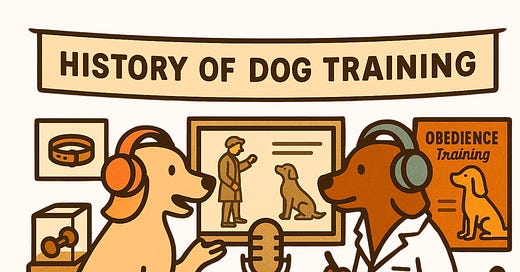In the second part of our series on Genealogy of Obedience, we follow the rise of positive reinforcement training from the 1980s to the early 21st century. This period is often seen as a moral turning point in dog training where science and compassion replaced dominance and force. But as Justyna Wlodarczyk shows, the story is more complicated. Even the kindest training methods can carry hidden forms of control. Drawing on Foucault’s idea of biopower, we explore how obedience became wrapped up in wellness, consumer culture, and the demand to self-regulate—for both dogs and their owners.
Key topics
The rise of positive reinforcement and the Karen Pryor era
Crossover trainers and the language of conversion
From physical control to behavioural science
Neoliberal self-regulation and “responsible ownership”
Emotional labour and the feminisation of training
Affirmative biopolitics and the compliant animal
Long-read article
The Karen Pryor moment: Science, dolphins, and the rejection of punishment
In the 1980s, Karen Pryor’s Don’t Shoot the Dog! became a foundational text for the modern positive training movement. Drawing on her work with dolphins, Pryor introduced operant conditioning as a humane, scientific alternative to dominance-based training. Her influence redefined what it meant to be a “good” trainer: not a disciplinarian, but a benevolent shaper of behaviour.
This shift marked a key discursive break. Training was no longer framed as domination but as cooperation, replacing coercion with reinforcement. Yet, as Wlodarczyk argues, the goal remained the same: the production of compliant, socially acceptable behaviour. The mode of power had changed—but not its function.
Crossover narratives: Redemption through reward
A new genre of dog training literature emerged: the crossover story, in which trainers publicly renounced punitive methods in favour of positive reinforcement. These stories, often structured like religious conversions, reinforced a moral hierarchy between “enlightened” science-based trainers and outdated, authoritarian ones.
This narrative served both ideological and commercial purposes. Trainers could establish credibility by confessing past sins, while aligning themselves with a growing market for “ethical” expertise. Wlodarczyk frames this as a technologisation of virtue: the dog becomes not just a well-behaved pet, but evidence of the owner’s moral progress.
From correction to cognition: Training as information management
As operant conditioning replaced leash jerks, training manuals began to adopt the language of learning theory and cognition. The dog was reframed as a thinking subject—a creature who could be taught to make good choices through environmental manipulation and feedback loops.
This mirrors what Foucault called the shift from disciplinary power to biopower: from punishing deviance to optimising life. Trainers stopped trying to “break” dogs and instead sought to shape their choices, anticipate their needs, and redirect their instincts. The leash was replaced by the clicker, but the logic of management remained.
Obedience in the age of neoliberalism
Modern training reflects not just scientific progress but broader political and economic shifts. In the neoliberal era, responsible dog ownership became a form of self-governance: owners are expected to manage their dogs’ behaviour in public, meet behavioural benchmarks, and perform emotional labour to ensure smooth social integration.
Dogs are now judged not only by what they do, but by how well they match middle-class ideals of restraint, sociability, and responsiveness. “Good” dogs reflect “good” owners—disciplined, self-improving, emotionally intelligent. Wlodarczyk argues that training has become a form of neoliberal governmentality, turning both human and dog into projects of optimisation.
The feminisation of training: Empathy, patience, and moral labour
Alongside this shift, dog training has been rhetorically and culturally feminised. Qualities once seen as weak—empathy, patience, emotional attunement—are now framed as necessary competencies. Trainers are expected to understand canine body language, manage their own emotions, and “listen” to the dog.
This shift has opened space for alternative epistemologies, including embodied and intuitive knowledge. But it also places new burdens on trainers and owners, especially women, to manage risk, emotion, and social harmony. Training becomes emotional labour—one that demands constant vigilance and self-regulation.
Affirmative biopolitics: Training as wellness
In the most recent phase of training discourse, obedience is reframed as well-being. Rather than just producing compliance, training is said to build confidence, reduce anxiety, and promote a dog’s true potential. This aligns with broader wellness culture, where optimisation is not just a duty but a path to happiness.
Wlodarczyk calls this affirmative biopolitics: power that presents itself as care. Rather than enforcing norms through punishment, it encourages subjects to internalise them as desires. The dog is not merely obedient—it wants to be. This creates a deeper form of control, masked as empowerment.
Practical takeaways
Reward isn’t neutral: Even positive methods carry ideological baggage. Trainers should reflect on the values and goals they embed in their methods.
Obedience is still political: Teaching a dog to behave “well” isn’t just about safety—it reflects cultural norms, expectations, and moral judgments.
Kindness can be discipline: Soft power is still power. Effective trainers should be honest about the control embedded in even the gentlest methods.
Source: Wlodarczyk, J. (2018). Genealogy of Obedience: Reading North American Dog Training Literature, 1850–2000. Brill.
Additional reading: Interview with the author













Share this post